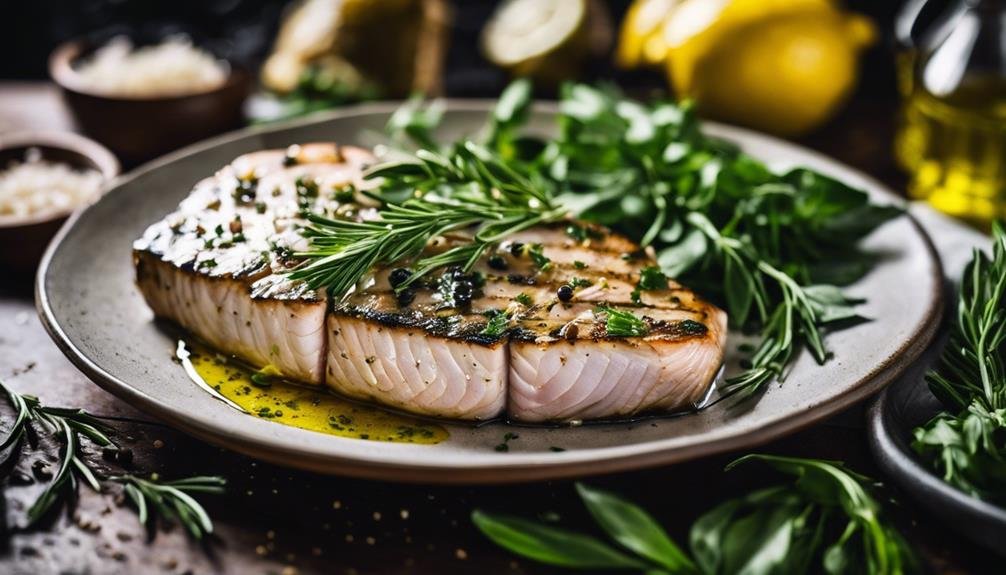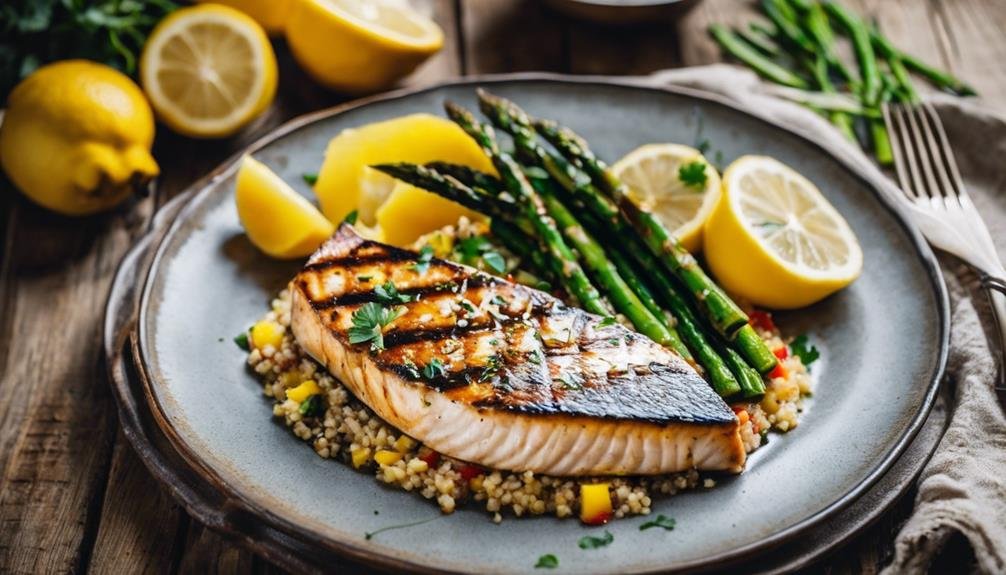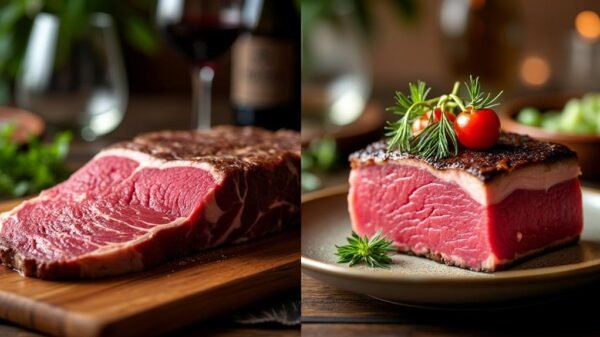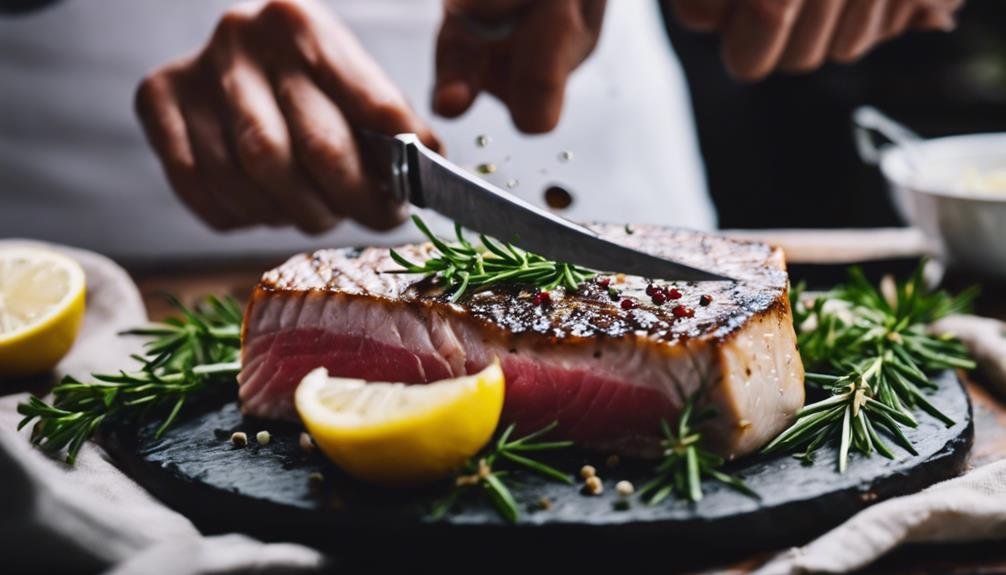Imagine the sizzling sound as your swordfish steak, seasoned to perfection, hits the hot grill – a symphony to the ears of any culinary enthusiast. You’ve selected a about an inch thick prime cut, embodying the first step to achieving the pinnacle of seafood cuisine.
Now, as you stand armed with tongs in one hand and a timer in the other, it’s essential to remember that the art of cooking swordfish is akin to a delicate dance between heat and time. By following a meticulously crafted sequence of steps, from pre-marination rituals to mastering the grill’s fiery temperament, you’re on the verge of revealing the secrets behind crafting a swordfish steak that’s not just good but legendary.
Yet, as we hover over the precipice of culinary mastery, one must wonder: what magic lies in the steps that transform a simple piece of fish into a masterpiece? Let’s set off on this gastronomic journey, where science meets humor, to discover how to consistently conjure the perfect swordfish steak from the comfort of your grill.
Cooking with Swordfish Key Takeaways
- Opt for swordfish steaks that are 1 to 1.5 inches thick and ensure they are dry before marination.
- To enhance flavor, marinate in a blend of olive oil, soy sauce, garlic, and lemon for 15 minutes.
- Grill over a two-zone fire at 400-450°F, aiming for a medium-rare finish and an internal temperature of 145°F.
- Let steaks rest under foil for 5-10 minutes post-grilling to ensure juiciness and tenderness before serving.
Selecting Your Steak
Choosing the perfect swordfish steak often feels like a culinary quest. You’ll want to arm yourself with the knowledge that freshness and a light, slightly reddish hue are your best allies in the pursuit of that ideal, flavorful bite. This isn’t just dinner; it’s an epic journey where grilled swordfish steaks are the prize, and your kitchen is the battleground.
First, thickness is your friend. Opt for steaks that are 1 to 1.5 inches thick. Anything thinner might give up the ghost before it hits the plate. Think of it as the armor that prevents your swordfish from turning into a culinary ghost story of overcooking.
Next, let’s talk about texture and color. You’re looking for the iron throne of swordfish steaks: firm texture and regal light color with a hint of a reddish tint. This isn’t just about aesthetics; it’s the hallmark of quality and freshness, ensuring your grilled masterpiece cooks evenly and avoids the dreaded dryness.
Pre-Marination Preparation
Before you immerse yourself in the art of marination, you’ll want to make certain your swordfish steaks are primed for perfection. This starts with a thorough drying and a gentle rubdown with olive oil, setting the stage for a flavor-packed culinary adventure. When it comes to pre-marination preparation, think of yourself as the maestro of a symphony, where the swordfish is your star violinist, requiring just the right touch to shine.
First, snag those fresh swordfish steaks, ideally 1 to 1.5 inches thick—any thinner, and they might pledge allegiance to the dominion of the overcooked. Drying them isn’t just a suggestion; it’s a culinary commandment. Why? Because water is the arch-nemesis of flavor absorption. Once they’re as dry as a humorist’s wit, it’s time for a light caress of olive oil. This isn’t just to make them gleam like a bodybuilder at a competition; it helps the seasoning cling to them like a koala to a tree.
Speaking of seasoning, sprinkling kosher salt and a dash of pepper will become your best friend. This dynamic duo sets the stage for the grill, ensuring that every bite is a harmonious blend of the sea’s bounty and a hint of the grill’s smoky whisper. Remember, this preparation prelude turns a good grilled swordfish into an unforgettable one.
Crafting the Perfect Marinade

Now that your swordfish steaks are prepped and primed, let’s whip up a marinade that’ll sing those flavors, starting with Mediterranean cumin, garlic, and olive oil. This isn’t your average grilled swordfish recipe; we’re diving deep into the art of marinade mastery with a dash of humor and a pinch of science.
Here’s how you concoct this flavor-packed potion:
- The Base: Mix 3 tablespoons of olive oil with 1 tablespoon each of soy sauce and sherry vinegar (or red wine vinegar for a twist). This oily, tangy base guarantees your swordfish doesn’t just swim in flavor but soaks it up like a sponge in the Mediterranean sea.
- The Aromatics: Crush 2 garlic cloves and whisk them into your base. Add a teaspoon of cumin for that earthy punch. These aren’t just flavors; they’re the molecules of merriment in your marinade.
- The Zest: Grate in the zest of one lemon and squeeze in its juice. This isn’t just citrus; it’s the zingy sunshine in your dish.
- The Wait: Let your swordfish bathe in this glorious mixture for 15 minutes at room temperature. This isn’t idle time; it’s when science does its magic, allowing flavors to penetrate deep into the steaks.
Grilling Techniques
With a perfectly marinated swordfish steak, let’s crank up the heat and explore the science and art of grilling, guaranteeing your culinary masterpiece is spectacular. Grilling techniques bridge the raw potential of fresh ingredients and the tantalizing promise of a perfectly cooked swordfish.
First and foremost, preheat your grill to medium-high heat, about 400-450°F. This range is the sweet spot where the magic happens, transforming the marinated swordfish into a symphony of flavors, kissed by heat and infused with black pepper and char aroma.
Before your swordfish touches the grill, remember to oil the grill grates. This little trick is like the secret handshake of grilling—it prevents sticking and ensures your fish gets those Instagram-worthy grill marks without a hitch. But resist the urge to move it around; let it sear in peace.
| Technique | Why It Matters |
|---|---|
| Two-zone fire | Direct heat sears the outside, while indirect heat gently cooks it through without drying it out. |
| Watchful eye | Swordfish cooks quickly. A moment too long, and you’re serving a fishy hockey puck. |
| Oil the grates | Prevents sticking and promotes those beautiful, sought-after grill marks. |
Testing for Doneness

After mastering the grill’s fiery dance, it’s time to guarantee your swordfish steak hits the perfect note of doneness. The science of serving up a swordfish symphony requires a blend of precision, intuition, and culinary magic. Here’s how to guarantee your fish dish receives a standing ovation:
- Deploy the Thermometer: An instant-read thermometer is your secret weapon. Aim for an internal temperature of 120°F to 130°F for a medium-rare performance, hitting those high notes with a firm texture that’s just right. Craving something more? Aim above these temperatures for a medium-well to medium-well encore.
- Visual Cues: Look for a slightly opaque center. This visual spectacle signifies that your swordfish steak is close to perfect doneness, allowing you to serve with confidence.
- The Touch Test: While more challenging due to its firm texture, gently pressing on your swordfish steak can offer insights into its readiness. A firmer feel indicates it’s nearing the final act.
- A Gentle Peek: Use a knife to sneak a peek of your swordfish steak stealthily. This method guarantees your dish remains picture-perfect while confirming it’s cooked to your liking.
Resting and Serving
Once your swordfish steak has gracefully exited the grill’s heat, a pivotal step awaits the rest period, a brief intermission allowing flavors to fuse and moisture to be uniformly distributed, guaranteeing your culinary masterpiece doesn’t just swim but soars upon serving. It’s a break for you and a scientific marvel for your dish. By resting your swordfish steak for 5-10 minutes, you’re not just watching time tick by; you’re letting the juices redistribute. This isn’t magic, though it might seem so; it’s the key to a moist and flavorful final dish.
Cover the swordfish loosely with foil during this resting period; think of it as tucking your steak in for a short nap, preserving its warmth and juiciness. This foil tent isn’t a culinary hat of shame but a crown, ensuring that the steak finishes its cooking journey perfectly without the risk of overcooking.
When the flavors have had time to meld, and the steak is tenderly whispering its readiness, it’s time to serve immediately. This guarantees a delicious and tender eating experience, enhancing taste and elevating your status from mortal to culinary hero. Resting isn’t just good manners; it’s science, working tirelessly to ensure your swordfish steak is spectacular.
Pairing With Sides

Selecting the perfect side dish for your swordfish steak isn’t just a culinary decision—it’s a science where flavors and textures engage in a delightful dance, elevating your meal from good to unforgettable. To assist in this gastronomic ballet, here’s a scientifically humorous guide to pairing your swordfish steaks with the ideal accompaniments:
- Lemony Potatoes: The zesty brightness of lemony potatoes acts as the perfect foil to swordfish’s rich, meaty texture. It’s like having a culinary cheerleader on your plate, encouraging every bite to be as lively as the first.
- Mediterranean Potato Salad: Tossing in a Mediterranean potato salad introduces a symphony of flavors that harmonize with the swordfish’s natural taste. Think of it as the string quartet to your steak’s solo performance—a blend of textures and tastes that’s music to your palate.
- Green Salad with Tahini Sauce: A crisp green salad drizzled with Tahini sauce brings a creamy, nutty dimension that complements the swordfish’s boldness. It’s the culinary equivalent of finding the perfect rhythm section for your meal’s headline act.
- Greek Salad or Bean Salad: For a punch of freshness and a nod to Mediterranean diet recipes, a Greek salad or bean salad serves as the vibrant, colorful backdrop that makes your swordfish steaks truly shine. It’s like adding the perfect accessory to an already stunning outfit.
Frequently Asked Questions
How Is Swordfish Supposed to Be Cooked?
Swordfish should be cooked to medium-rare perfection, similar to treating it like a rare steak. This involves grilling or pan-searing it to reach an internal temperature of 120-130°F, ensuring it remains moist and tender.
How Do You Keep Swordfish From Overcooking?
To avoid overcooking swordfish, remove it from the heat slightly before it is fully cooked. Allowing it to rest will enable it to continue cooking perfectly, impressing your guests.
What Is the Best Doneness for Swordfish?
Medium-rare, with an internal temperature of 120°F to 130°F, is the best doneness for swordfish. This ensures it remains tender, juicy, and flavorful, making it an impressive choice for any culinary occasion.
Should Swordfish Be Cooked at Room Temperature?
Yes, allowing your swordfish to reach room temperature before cooking is advisable. This approach ensures that it cooks evenly, preventing a tough exterior and achieving juicy perfection that will impress your dinner guests.
Conclusion
Now, you’ve mastered the art of cooking the perfect swordfish steak, a feat that marries science with culinary finesse.
You’ve elevated your kitchen game by choosing the right steak, lovingly prepping it, concocting a divine marinade, and mastering the grill’s fiery embrace.
Remember, it’s not just about hitting that sweet 135°F spot; the rest weaves the magic, locking in those succulent juices.
Serve it up, pair it wisely, and watch as your dinner table becomes the night’s epicenter of gastronomic delight.
Bon appétit!


































